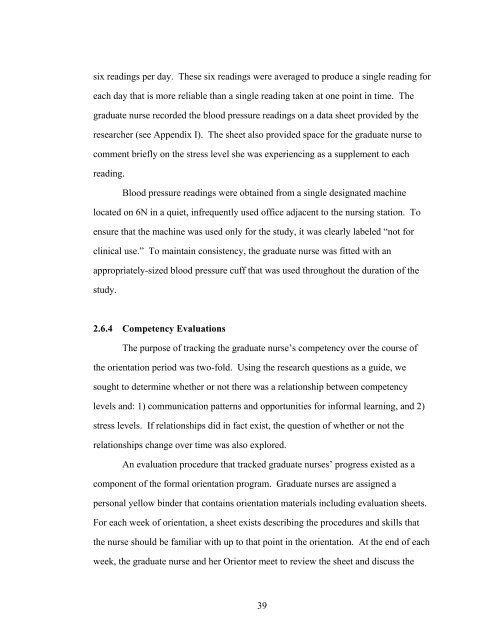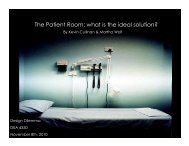The role of physical design and informal communication
The role of physical design and informal communication
The role of physical design and informal communication
You also want an ePaper? Increase the reach of your titles
YUMPU automatically turns print PDFs into web optimized ePapers that Google loves.
six readings per day. <strong>The</strong>se six readings were averaged to produce a single reading for<br />
each day that is more reliable than a single reading taken at one point in time. <strong>The</strong><br />
graduate nurse recorded the blood pressure readings on a data sheet provided by the<br />
researcher (see Appendix I). <strong>The</strong> sheet also provided space for the graduate nurse to<br />
comment briefly on the stress level she was experiencing as a supplement to each<br />
reading.<br />
Blood pressure readings were obtained from a single <strong>design</strong>ated machine<br />
located on 6N in a quiet, infrequently used <strong>of</strong>fice adjacent to the nursing station. To<br />
ensure that the machine was used only for the study, it was clearly labeled “not for<br />
clinical use.” To maintain consistency, the graduate nurse was fitted with an<br />
appropriately-sized blood pressure cuff that was used throughout the duration <strong>of</strong> the<br />
study.<br />
2.6.4 Competency Evaluations<br />
<strong>The</strong> purpose <strong>of</strong> tracking the graduate nurse’s competency over the course <strong>of</strong><br />
the orientation period was two-fold. Using the research questions as a guide, we<br />
sought to determine whether or not there was a relationship between competency<br />
levels <strong>and</strong>: 1) <strong>communication</strong> patterns <strong>and</strong> opportunities for <strong>informal</strong> learning, <strong>and</strong> 2)<br />
stress levels. If relationships did in fact exist, the question <strong>of</strong> whether or not the<br />
relationships change over time was also explored.<br />
An evaluation procedure that tracked graduate nurses’ progress existed as a<br />
component <strong>of</strong> the formal orientation program. Graduate nurses are assigned a<br />
personal yellow binder that contains orientation materials including evaluation sheets.<br />
For each week <strong>of</strong> orientation, a sheet exists describing the procedures <strong>and</strong> skills that<br />
the nurse should be familiar with up to that point in the orientation. At the end <strong>of</strong> each<br />
week, the graduate nurse <strong>and</strong> her Orientor meet to review the sheet <strong>and</strong> discuss the<br />
39







